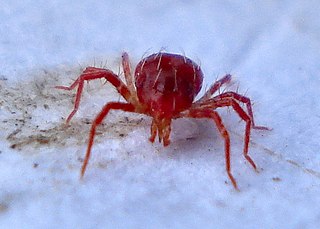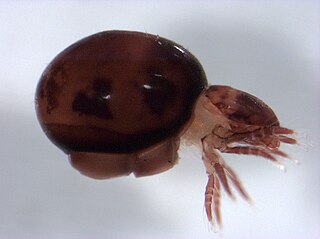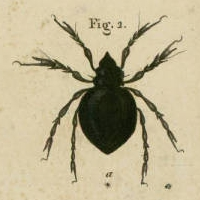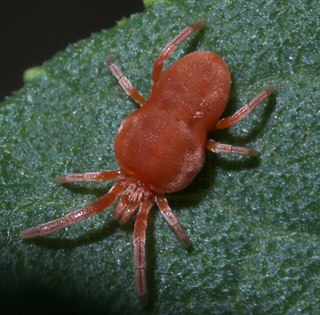Related Research Articles

The Phytoseiidae are a family of mites which feed on thrips and other mite species. They are often used as a biological control agent for managing mite pests. Because of their usefulness as biological control agents, interest in phytoseiids has steadily increased over the past century. In 1950, there were 34 known species. Today, there are 2,731 documented species.

Oribatida, also known as oribatid mites, moss mites or beetle mites, are an order of mites, in the "chewing Acariformes" clade Sarcoptiformes. They range in size from 0.2 to 1.4 millimetres. There are currently 12,000 species that have been identified, but researchers estimate that there may anywhere from 60,000 to 120,000 total species. Oribatid mites are by far the most prevalent of all arthropods in forest soils, and are essential for breaking down organic detritus and distributing fungi.
The Raphignathoidea is a superfamily of the Acari (mite) Order Trombidiformes. It contains many predators of small invertebrates, while some are herbivores and others parasites.

Raoiella indica, commonly known as the red palm mite, is a species of mite belonging to the family Tenuipalpidae. A pest of several species of palm in the Middle East and South East Asia, it is now becoming established throughout the Caribbean. The invasion of this species is the biggest mite explosion ever observed in the Americas.

Lorryia formosa, commonly known as the yellow mite or the citrus yellow mite, is a species of acariform mite. They are in the subfamily Tydeinae of the family Tydeidae. Commonly found on the foliage of citrus trees around the world, Lorryia formosa also associates with a variety of other plant types. The life cycle includes six discrete stages of development, and the lifespan averages about 37 days. The females of the species use an asexual form of reproduction where the growth and development of embryos occurs without fertilization by a male, a process called thelytoky.
Austrophthiracarus is a genus of mites in the family Steganacaridae.
Ameroseiidae is a family of mites in the order Mesostigmata.
Pneumolaelaps is a genus of mites in the family Laelapidae.

Aceria tosichella, commonly known as the wheat curl mite (WCM), is a global cereal pest and a vector for spreading and transmission of viruses like wheat streak mosaic virus (WSMV) and wheat mosaic virus (WMoV)
Charletonia cuglierensis is a species of mite belonging to the family Erythraeidae, so named after its type locality. C. cuglierensis belongs to the group of species which possess two setae between coxae II and III. It differs from its cogenerate species by length measurements. It was first found in Sardinia, 6 kilometres (3.7 mi) south of Cuglieri.
Allothrombium polikarpi is a species of mite belonging to the family Trombidiidae, first described from Greece.
Erythraeus (Zaracarus) kastaniensis is a species of mite belonging to the family Erythraeidae, first described from Greece.
Charletonia samosensis is a species of mite belonging to the family Erythraeidae, first described from Greece.
Charletonia kalithensis is a species of mites belonging to the family Erythraeidae, first described from Greece.
Galumna pseudokhoii is a species of mite first found in Cát Tiên National Park, Vietnam, in dark loam in a Lagerstroemia forest. This species is very similar in the location and morphology of notogastral areae porosae, rostral morphology, lamellar and interlamellar setae, lamellar lines locations, and incomplete dorsosejugal suture to Galumna khoii, differing in body size, sensilli morphology, and the number of genital setae on the anterior parts of its genital plates.

Belba is a genus of mites belonging to family Damaeidae. The genus was established by Carl von Heyden in 1826. Notaspis corynopus was the type species. Species that are part of the genus can be found in Eurasia and North America.

Cocceupodidae is a family of mites in the order Trombidiformes. There are at least 3 genera and about 23 described species in Cocceupodidae.

Neotrombidiidae is a family of velvet mites and chiggers in the order Trombidiformes. There are at least four genera in Neotrombidiidae.

Allothrombium is a genus of mites belonging to the family Trombidiidae.
Fritz S. Lukoschus (1919–1987) was a German zoologist studying the systematics and biology of the Acari. Over the course of his career he published over 200 scientific articles, describing more than 90 species new for science. Lukoschus was born in April 1919 in Grabsten in April 1919. He obtained his PhD in 1946 from the University of Göttingen on a thesis on the development of castes in the European honey bee. After working at the University of Göttingen until 1953, he worked at several institutions before being recruited by the Catholic University of Nijmegen in 1962 where he stayed until his retirement in 1984. Lukoschus died suddenly in August 1987. The genera Lukoschus and Lukoschuscoptes were named after him.
References
- Ahaniazad, M. et al. 2013: A new species of Neophyllobius from Iran, re-description of Stigmaeus echinopus Summers and a key to the Iranian species of Neophyllobius (Acari: Trombidiformes: Prostigmata). International journal of acarology, 39(4), pages 341–346, doi : 10.1080/01647954.2013.777781
- Bolland, H.R. 1991: Review of the systematics of the family Camerobiidae. II. The genus Neophyllobius Berlese, 1886 (Acari: Raphignathoidea). Genus, 2, pages 59–226
- Bolland, H.R.; Swift, S.F. 2000: Hawaiian Raphignathoidea: family Camerobiidae (Acariformes: Prostigmata), with descriptions of three new species. International journal of acarology, 26(4), pages 347–356, doi : 10.1080/01647950008684209
- Fan, Q.-H.; Zhang, Z.-Q. 2005: Raphignathoidea (Acari: Prostigmata). Fauna of New Zealand, (52)
- Khanjani, M.; Fayaz, B.A.; Ghanbalani, G.N. 2010: Two new species of the genus Neophyllobius Berlese (Acari: Camerobiidae) from Iran. Zootaxa, 2521, pages 53–64
- Khanjani, M.; Hoseini, M.A. 2013: Three new species of the genus Neophyllobius Berlese (Acari: Camerobiidae) from Southern and Southwestern Iran. Zootaxa 3666(4), pages 510–522,doi : 10.11646/zootaxa.3666.4.6
- A new species of Neophyllobius Berlese (Acari: Camerobiidae) from Turkey. K KOC, N MADANLAR, Acarologia, 2001
- Neophyllobius pistaciae n. sp.(Acari: Camerobiidae) from Iran. HR Bolland, MR Mehrnejad, International Journal of Acarology, 2001
- Mites of the genus Neophyllobius. EA McGregor, Bulletin of the Southern California Academy of …, 1950
| Wikispecies has information related to Neophyllobius . |